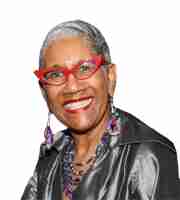By ANTONIA WILLIAMS-GARY
Once, while in graduate school, I read a book that taught how to lie with statistics, so I won’t bore you here with any bold facts.
But, think about this: if we only had televised commercials to guide our thinking, we’d be convinced that we live in a perfect world, you know, where everyone is prosperous and living in harmony with one another; i.e., other races and various ethnically diverse groups, which are also demographically balanced with old folk, young folk, all ‘others.’
My personal favorite is an ad which features a couple of older whites (grandparents?) with a very young girl of color (granddaughter?), and a voice over talking about how the world has changed.
Indeed.
Then, my next favorite is one showing a neighborhood picnic where the participants represent one from every column of demographic in the USA. Everyone looks happy sitting at a long table filled with an overabundance of food-stuffs.
I think that one might be selling the benefits of shopping at a particular grocery store chain.
But in the above two examples, it doesn’t really matter what products/services are being sold; the images are what matter most.
Believable? Yes. But not reality. “Madison Avenue’ is the generic term we use to attribute where these images are created, and it continues to offer a ‘snow job’ to the consumer market.
That’s right: a perpetual white-washing our real-life experiences of what it’s really like to live in the USA.
Don’t take my word for it, just turn on your screen and watch the commercials for products aimed at a national market.
Boy, if we could all live in that world. But we know there is no such place called “OZ.”
In fact, too many brown and black folk live in communities and neighborhoods where the closest place for buying food and other essential commodities is still the corner convenience store; if even that.
I had never heard of a ‘food desert’ until I moved to Dallas. South Dallas is not far from where I live. It is a long-suffering area which still does not have more than one location to purchase what a family needs to fill their pantry; a grocery store is on the books for development – soon.
Paul Quinn College is located in that area.
To its credit, the college turned its unused football field into an urban farm which provides fresh produce to the community. It also offers a degree in urban agriculture – the wave of the future?
Still. Our modern society is filled with huge gaps to access or opportunity, and is peppered with suffering from years of sheer neglect, which are spread to every corner of this country.
For years, the USA has been the bread basket of the world: our corn, wheat, and grain reserves can feed tens of millions, yet we have people starving here at home. Go figure.
Our government’s efforts to improve the lives of our own citizens miss the mark by a long shot because there is no political will to correct the problems here at home; the idea that there may be inequity across this land is so politically distasteful.
Yet, we continue to send food abroad to feed the famished poor in Africa, and other food-poor countries – to the detriment of the poor and dispossessed folk here.
All the while, the commercials show us images of prosperity, parity, and a level demographic playing field.
That’s for sure a cluster mind distortion. Just how far do you have to drive to get to a decent grocery store in your own neighborhood?
And, do you even know what’s going on in your own school districts?
Again, no statistics, but we know that many of our children are not getting a nutritious breakfast in their own home, but there is a growing movement toward cutting subsidized school food programs marching across the nation.
Has your Greek, civic/social organization, place of worship adopted a local school’s breakfast or lunch program?
By the way, does your church/temple/mosque, send food abroad?
Wake up everyone. There is a mid-term election coming up in 2018.
“We the people” has to mean something. Doesn’t it?
Toniwg1@gmail.com










No Comment